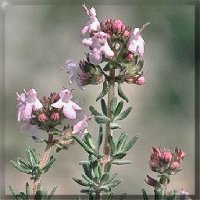

Thymus vulgaris


Thymus vulgaris
Description - Thyme is native to the Mediterranean region. Thymus vulgaris, also known as Creeping Thyme, Mountain Thyme, and Wild Thyme, a small shrubby plant with a strong, spicy taste and odor, is extensively cultivated in Europe and the U.S. for culinary use. The numerous quadrangular, procumbent, woody stems grow from 6 to 10 inches high and are finely hairy. Slightly downy on top and very downy underneath, the opposite, sessile leaves are ovate to lanceolate in shape and have slightly rolled edges. The small bluish-purple, two-lipped flowers are whorled in dense, head-like clusters, blooming from May to September. In traditional European herbalism, thyme was used to treat respiratory infections, laryngitis, tonsillitis, sore throats, irritable coughs, bronchitis, whooping cough, asthma and catarrhal coughs.
Pharmacology - The essential oils of thyme are grouped into three main types: thyme oil, which contains 42 to 60% phenols and is mainly thymol; origanum oil, which contains 63 to 74% phenols and is mainly carvacrol; and lemon thyme oil, which contains citral. Thyme oil is divided into two types, a red, unrectified oil and a white, rectified oil. An oleoresin is also extracted and commercially available. Both the essential oil and oleoresin of thyme are used in the flavour and food industries. As a pharmaceutical, the oils thymol and carvacrol are used in mouthwashes, toothpastes, soaps, creams, salves, lotions, liniments, throat lozenges, and cold remedies. The oil is also used in the manufacture of perfumes and cosmetics. The oil is extracted, by steam distillation, from the fresh or dried leaves and flowering tops of the plant. Ideally, thyme should be collected when in flower, and carefully dried. Oil content of the dried plant material is 2 to 5%. It has a strong, pungent, spicy, tangy, herby, rather pleasant taste and odour, both of which are retained by careful drying. The essential oil is mainly located in small glands on the leaves and contains thymol, paracymene & linalol.
The actions of the plant include carminative, antimicrobial, antispasmodic, expectorant, astringent, and anthelmintic. Chemicals contained in the herb responsible for these actions include a volatile oil composed of thymol, carvacrol, cineole, borneol, geraniol, linalool, bornyl and linalyl acetate, thymol methyl ether and alpha pinene. Its flavonoids include apigenin, luteolin, thymonin, and naringenin. Also included are labiatic acid, caffeic acid and tannins.
Medicinal Uses - Thyme is commonly used in throat and bronchial problems, including acute bronchitis, laryngitis, and whooping cough, and also for diarrhea, chronic gastritis, and lack of appetite. For coughs and spasmodic complaints, the medication is made from the fresh plant. A warm infusion promotes perspiration and relieved flatulence and colic. Oil of Thyme (thymol) has a powerful antiseptic action for which it was used in mouthwashes and toothpastes. Thymol is also effective against ascarids and hookworms. As a local irritant, it was used externally for warts or to encourage the flow of blood to the surface. Thyme baths are said to be helpful for neurasthenia, rheumatic problems, paralysis, bruises, swellings, and sprains. A salve made from thyme was once used for shingles.
Toxitity, Cautions and Contraindications - Excessive internal use of Garden thyme can lead to symptoms of poisoning and to over-stimulation of the thyroid gland. Avoid therapeutic doses during pregnancy. As with most essential oils, it must be diluted before applying to the skin.